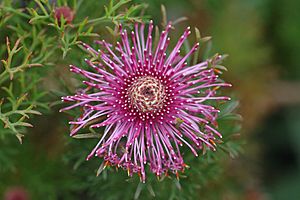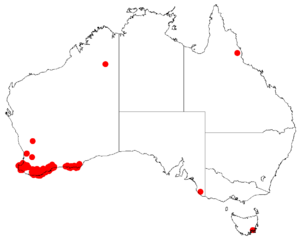Rose coneflower facts for kids
Quick facts for kids Rose coneflower |
|
|---|---|
 |
|
| Isopogon formosus at San Francisco Botanical Garden | |
| Scientific classification | |
| Genus: |
Isopogon
|
| Species: |
formosus
|
 |
|
| Occurrence data from Australasian Virtual Herbarium | |
| Synonyms | |
|
|
The rose coneflower, also known as Isopogon formosus, is a beautiful flowering plant. It belongs to the Proteaceae family. This plant grows naturally only in the south-west part of Western Australia. It is a type of shrub. Its leaves are divided into thin, tube-like parts. The plant has round or oval flowers that are pink or red.
Contents
What the Rose Coneflower Looks Like
The rose coneflower is a shrub that can grow upright or spread out. It usually reaches a height of about 1.5 to 2 meters (5 to 6.5 feet). Its young branches are light to reddish-brown.
The leaves can be up to 35 millimeters (about 1.4 inches) long. They grow on a stalk called a petiole, which can be up to 25 millimeters (about 1 inch) long. The leaves are split into grooved, cylinder-shaped pieces. Each piece has a sharp, pointed tip.
The flowers grow at the ends of the branches or where leaves meet the stem. They form round or oval heads, about 60 millimeters (about 2.4 inches) wide. At the base of these flower heads are special leaf-like parts called involucral bracts. The flowers themselves are red or pinkish-purple. They are mostly smooth, without hairs. After flowering, the plant produces a hairy nut. These nuts join together to form a round or oval head up to 20 millimeters (about 0.8 inches) wide.
How the Rose Coneflower Got Its Name
The rose coneflower was first officially described in 1810. A botanist named Robert Brown gave it its scientific name, Isopogon formosus. He published his description in a scientific paper.
The word formosus comes from Latin. It means "beautifully-formed" or "handsome." So, its name basically means "beautiful Isopogon."
In 1995, another botanist, Donald Bruce Foreman, described two slightly different types of Isopogon formosus. These are called subspecies. They are:
- Isopogon formosus subsp. dasylepis: This type generally has more hairs on its stems, leaves, and flower bracts. It mainly flowers from June to December.
- Isopogon formosus subsp. formosus: This type is mostly smooth, with fewer hairs. It usually flowers from May to November.
These subspecies help scientists group plants that are very similar but have small differences.
Where the Rose Coneflower Grows
The rose coneflower grows in many different kinds of soil. You can find it in wet, swampy areas, on rocky hills, and on sandy plains. It mostly grows between the towns of Bunbury and Esperance in Western Australia.
The dasylepis subspecies grows between Busselton, Noggerup, and the Scott River. The formosus subspecies grows closer to the coast. You can find it between Walpole and Hopetoun, and from Dalyup to Cape Arid National Park.
Protecting the Rose Coneflower
The Government of Western Australia's Department of Parks and Wildlife keeps track of how many of these plants there are.
The formosus subspecies is considered "not threatened." This means there are enough of them, and they are not in danger.
However, the dasylepis subspecies is classified as "Priority Three." This means it's not very well known, and it's only found in a few places. While it's not in immediate danger, scientists are keeping an eye on it to make sure it stays safe.
Growing Rose Coneflower in Gardens
If you want to grow Isopogon formosus in a garden, it needs a few important things. It must have excellent drainage, meaning water should not sit around its roots. It also needs a lot of sunshine. This plant does not like long dry periods or very cold frosts.

